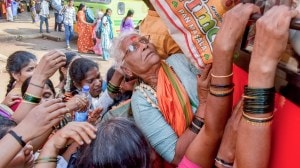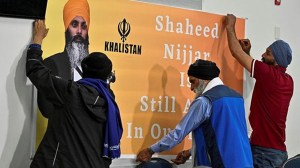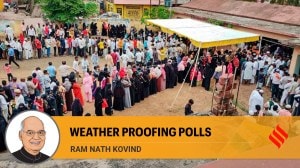- India
- International
UPSC Key | 24th April, 2024 — Ethylene oxide, SIPRI Report, organ transplants and more
Exclusive for Subscribers from Monday to Friday: How are Ethylene oxide and SIPRI report relevant to the UPSC Exam? What significance do topics like organ transplants and RBI's State of the economy report have for the preliminary and main exams? You can learn more by reading the Indian Express UPSC Key for April 24, 2024.
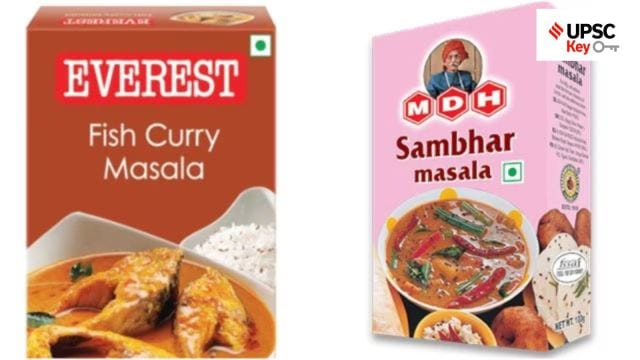 The CFS said it had collected the samples from three retail outlets in Tsim Sha Tsui respectively for testing under its routine Food Surveillance Programme. Know more in our UPSC Key. (Photos: everestfoods.com/mdhspices.com)
The CFS said it had collected the samples from three retail outlets in Tsim Sha Tsui respectively for testing under its routine Food Surveillance Programme. Know more in our UPSC Key. (Photos: everestfoods.com/mdhspices.com)Important topics and their relevance in UPSC CSE exam for April 24, 2024. If you missed the April 23, 2024 UPSC CSE exam key from the Indian Express, read it here.
🚨 The Indian Express UPSC Essentials brings to you the April edition of its monthly magazine. Click Here to read. Share your views and suggestions in the comment box or at manas.srivastava@indianexpress.com🚨
Explained Page
Ethylene Oxide
Syllabus:
Preliminary Examination: Current events of national importance
Mains Examination: GS-II, GS-III: Issues Relating to development and management of Social Sector/Services relating to Health,
What’s the ongoing story- Food Safety and Standards Authority of India (FSSAI) will conduct checks on products of spice brands MDH and Everest Group after authorities in Hong Kong and Singapore last week determined that four of their mixes contained high levels of carcinogen ethylene oxide. If the two manufacturers are found guilty, action would be taken as per the Food Safety Act.
Prerequisites:
— What is ethylene oxide?
— Read about the FSSAI
— What is E. coli and Salmonella?
Key takeaways:
— “Ethylene oxide is a pesticide that has been classified as a Group 1 carcinogen by the International Agency for Research on Cancer, meaning there is sufficient evidence from human studies that it can cause cancer,” says Kanika Narang, nutritionist at Indraprastha Apollo Hospitals, New Delhi.

— It is used by the spice industry as a fumigant to reduce microbial contamination, such as E. coli and Salmonella. It is a colourless, highly flammable and very reactive gas that kills bacteria, viruses and fungi. It is an industrial chemical.
— Ethylene oxide can damage DNA during sterilisation procedures.
— “While the risk from occasional, low-level exposure may be minimal, spices and spice blends like those flagged are commonly used in household cooking across multiple dishes. This can lead to chronic, persistent exposure over time, which has been linked to an increased risk of cancers like leukemia, stomach cancer and breast cancer. It can even lead to respiratory irritation and lung injury, headache, nausea, vomiting, diarrhoea and shortness of breath.” Narang said.
For Your Information:
— Escherichia coli (E.coli) is a bacterial strain that is commonly found in the intestines of people and animals, fecal waste of cattle and humans.
— Salmonella is a group of bacteria that can cause food-borne illnesses known as salmonellosis. The World Health Organisation (WHO) identifies Salmonella as one of four key global causes of diarrhoeal diseases.Individuals who develop salmonellosis may show symptoms such as nausea, diarrhoea, fever, and abdominal cramps 12-72 hours after contracting the infection.
Do you know: India is the world’s largest producer, consumer and exporter of spices.
Points to Ponder:
— How can ethylene oxide impact health?
— Where else is ethylene oxide banned?
— What is listeria?
— What are the challenges associated with the food safety in India?
Post Read Question:
Consider the following statements with regard to ethylene oxide?
1. It is a colourless, highly flammable and very reactive gas that kills bacteria and viruses only.
2. It is a pesticide that has been classified as a Group 1 carcinogen.
How many of the statements given above are correct?
(a) Only one
(b) Only two
(c) Both 1 and 2
(d) None
Other Important Articles Covering the same topic:
FSSAI sets up lab network to test food for pathogens
Explained: MDH masalas in US have tested positive for Salmonella. What is it?
E.coli detection kit now available at nominal price
The Ideas Page
Time to heal
Syllabus:
Preliminary Examination: Current events of national and international importance.
Mains Examination: GS-III: Linkages between development and spread of extremism, role of external state and non-state actors in creating challenges to internal security. Preliminary Examination: Current events of national and international importance.
What’s the ongoing story- Prakash Singh writes-“Security forces dealt a decisive blow to the Maoists on April 14 in Kanker district, Chhattisgarh, near the Maharashtra border. A joint force of the BSF and district reserve guard engaged a division of Maoists on the periphery of Abujmarh in Binagunda and Koronar forests, and killed 29 of them, including three senior commanders. This was the highest number of casualties that the Maoists have suffered in a single operation in Bastar.”
Prerequisites:
— What is the Maoist movement?
— What is insurgency?
— What is Left-wing-extremism (LWE)?
— What is the “National Policy and Action Plan to address LWE”?
Key takeaways:
— According to the Minister of State for Home Affairs Nityananda Rai, the implementation of the “national policy and action plan” had resulted in a consistent decline in violence and constriction of the geographical spread of LWE influence.
— According to the South Asia Terrorism Portal, sustained pressure on Naxalites has also resulted in a large number of surrenders over the past few years. It is estimated that 16,780 Naxalites surrendered between March 6, 2000, and April 7, 2024.
— Prakash Singh opines- “the problem of Naxalism refuses to die down even though there has been considerable attrition in the Naxal ranks. The hard fact is that the Maoists still have adequate strength and firepower to launch lethal attacks on security forces and create significant law and order problems.”
— “There are major flaws in the government’s approach to tackling the Naxal problem. There is no overall strategic plan and the states have been tackling the challenge as per their perception and the political appreciation of its gravity.”
— “States consider LWE a national problem. The problem will not be conclusively dealt with until state forces take the lead in anti-Naxal operations and the central armed police forces play a subsidiary role only.”
— “The whole-of-government approach is also missing on the ground. The security forces can clear an area of Naxals but, thereafter, the administration has to step in and establish infrastructure. This is not happening, with the result that an area cleared yesterday is re-occupied by Maoists tomorrow.”
— “India’s forest cover is being gradually denuded. Tribals inhabiting these forest areas were displaced in the process. Deprived of their land and any regular means of livelihood, many of them gravitated towards the Naxals.”
— “The World Inequality Lab (WIL) paper titled ‘Income and Wealth Inequality in India, 1922-2023: The Rise of the Billionaire Raj’ revealed that the share of wealth with the top 1 per cent of the population was 40.1 per cent in 2022-2023.”
— “Now that the government has the upper hand, it is the right time to initiate peace dialogue with the Naxal leadership.”
For Your Information:
— In 2009, then-Prime Minister Manmohan Singh described Naxalism as “the gravest internal security threat to our country”
To know more: UPSC Key– 19th April, 2024
Points to Ponder:
— What do you understand by Red corridor?
— What is the difference between insurgency, militancy, and extremism?
— Why do Maoists continue to have a significant presence in Chhattisgarh?
— What are the government initiatives to control LWE?
Post Read Question:
What is the Left-wing-extremism? Why does it continue to exist in the regions of Chhattisgarh? What approach needs to be taken?
Other Important Articles Covering the same topic:
Prakash Singh writes: Maoism should be seen as a social and economic problem
A war, an abyss
Syllabus:
Preliminary Examination: Current events of national and international importance.
Mains Examination: GS-II: Effect of policies and politics of developed and developing countries on India’s interests.
What’s the ongoing story- Anju Gupta writes- “Six months after the October 7 attack, Israel’s war to eliminate Hamas has resulted in the near-complete destruction of Gaza and a dire humanitarian crisis with the area on the verge of famine. Iran and its allies have militarily united behind the Palestinian cause and expanded the confrontation to other parts of the region. However, the dynamics of war have drastically changed following the massive Iranian drone and missile attacks on military targets in Israel on April 14”
Prerequisites:
— What is Hamas and the Israel-Hamas War?
— What is the ‘Middle East’?
— Map work: Tel Aviv, Damascus, Tehran, key countries of the region: Egypt, Iran, Israel, Qatar, Turkey, Saudi Arabia, UAE, Red Sea, Strait of Hormuz, Persian Gulf, Gulf of Oman, Gulf of Aden, Bab-el-Mandeb, Isfahan, Panama Canal, Palestine and Gaza Strip
Key takeaways:
— “The geopolitics of the region (middle east) has already undergone a sea change since October 7 in four substantive ways.-
(i) First, thawing of the hitherto icy Shia-Sunni relationship, with Hezbollah, Houthis and Iran (all Shia entities) extending open support to “Sunni” Palestinians, presenting regional unity via the Axis of Resistance, opposing US-Israel domination.
(ii) Second, the war has expanded across the region, pushing the US to become the fulcrum of efforts to contain expansion and making it a primary target.
(iii) Third, the Saudi-aligned Sunni Arab States have adopted the political and diplomatic route, advocating a ceasefire, supporting humanitarian assistance, and calling for a two-state solution while remaining in line with US-led initiatives.
(iv) Fourth, the Yemen-based Houthis — a non-state actor devoid of a navy — have managed to successfully disrupt a critical sea lane of communication for five months, impairing trade substantively.
— The cost of war: “The expansion of the war has already caused economic distress to the Israeli economy. The Israeli economy has reportedly shrunk by 20 per cent in the last quarter of 2023. Two crucial Israeli ports, Eilat on the Red Sea and Haifa on the eastern Mediterranean have been sporadically attacked. The Eilat port is said to be down to a quarter of its business, while Israeli media reports an acute shortage of labour in Israel, primarily on account of military conscription and volunteerism. Following the Israel-Iran confrontation, on April 19, S&P lowered Israel’s long-term rating by a notch.”
Points to Ponder:
— What is ‘Operation Al-Aqsa Flood’?
— How has the Israel-Hamas-Iran conflict led to a more volatile Middle East?
— The Middle East is one of the most successful regions for Indian diplomacy over the last decade but it continues to test Delhi’s ability to navigate the region’s competing imperatives. Discuss.
Post Read Question:
The term “two-state solution” is sometimes mentioned in the news in the context of the affairs of (2018)
(a) China
(b) Israel
(c) Iraq
(d) Yemen
Other Important Articles Covering the same topic:
A to Z of the Israel-Palestine conflict
Express Network
India 4th largest military spender in 2023: SIPRI
Syllabus:
Preliminary Examination: Current events of national and international importance
Mains Examination: GS-II, GS-III: Government policies and interventions for development in various sectors, indigenization of technology,
What’s the ongoing story- With military expenditure worth $83.6 billion in 2023, India was the fourth largest spender globally in 2023, the latest report by Stockholm International Peace Research Institute (SIPRI) states. This was a result of growing personnel and operations costs that comprised about 80 per cent of the total military budget, the report said.
Prerequisites:
— What is SIPRI?
— What do you understand by the indigenization of defense?
— What is the state of defense equipment imports in India?
— Which countries are the top arms suppliers to India?
Key takeaways:
— The latest data showed that the United States, China and Russia remained the top three military spenders globally followed by India and Saudi Arabia.
— According to the report, Indian spending was up by 4.2 per cent from 2022 and by 44 per cent from 2014.
— The capital outlays to fund military procurement remained relatively stable at around 22 per cent of the budget in 2023, of which 75 per cent went towards equipment produced domestically.
— As per the report the five biggest spenders in 2023 –the United States, China, Russia, India and Saudi Arabia—together accounted for 61 per cent of world military spending. The US spending was $916 billion and the Chinese spending was an estimated $296 billion. Russia’s military spending grew by 24 per cent in 2023 to an estimated $109 billion.
— As per the report, Ukraine became the eighth largest military spender in 2023, increasing its spending by 51%.
Points to Ponder:
— What is the new FDI policy in the defense sector?
— What is the Innovations for Defence Excellence (iDEX) initiative?
— What are the government initiatives for promoting the indigenization of technology in the defense sector?
— What are the challenges associated with the indigenization of the Indian defence sector?
Post Read Question:
Prelims
Which one of the following is the best description of ‘INS Astradharini’, that was in the news recently? (2016)
(a) Amphibious warfare ship
(b) Nuclear-powered submarine
(c) Torpedo launch and recovery vessel
(d) Nuclear-powered aircraft car
Mains
“The continued shift towards domestic procurement of defence equipments reflects India’s goal of becoming self-reliant in arms development and production,” Comment.
(Thought process: Build it on the significance of domestic procurement for promoting the indigenization of technology, then connect what are the factors that can play a key role in increasing India’s share in arms sales and what are the government initiatives in the same direction. )
Other Important Articles Covering the same topic:
India’s atmanirbhar defence sector
What India needs to do to plug its defence gap
Asia worst hit by disasters in 2023, 79 extreme weather events killed over 2k
Syllabus:
Preliminary Examination: General issues on Environmental Ecology, Biodiversity and Climate Change – that do not require subject specialisation.
Mains Examination: GS-III: Conservation, environmental pollution and degradation, environmental impact assessment.
What’s the ongoing story- The World Meteorological Organization’s ‘State of the Climate in Asia 2023’ report notes that Asia has warmed faster than the global average and the warming trend has nearly doubled since the 1961-1990 period.
Prerequisites:
— What is a heatwave?
— What are tropical cyclones?
— What is Glacial Lake Outburst Flood (GLOP)?
Key takeaways:
— According to the report, Asia faced the most disasters in the world as 79 events associated with extreme weather, climate, and water-related hazards in 2023 affected over nine million people in the region, directly killing over 2,000 people.
— The report said flood events occurred in India during August 2023 and Himachal Pradesh and Uttarakhand recorded 25 deaths as well as extensive damage to infrastructure and agriculture.
— “The Indian sub-continent experienced six tropical cyclones in 2023 which formed in the North Indian Ocean. The cyclone activity was slightly above the average of 5.4 cyclones.”
— The report also took note of the “significant glacial lake outburst flood” that occurred in South Lhonak Lake in Sikkim on October 4 last year.
— “This type of disaster is increasingly observed because of climate change-induced glacier retreat and highlights the compounding and cascading risks faced by vulnerable mountain communities.”
For Your Information:
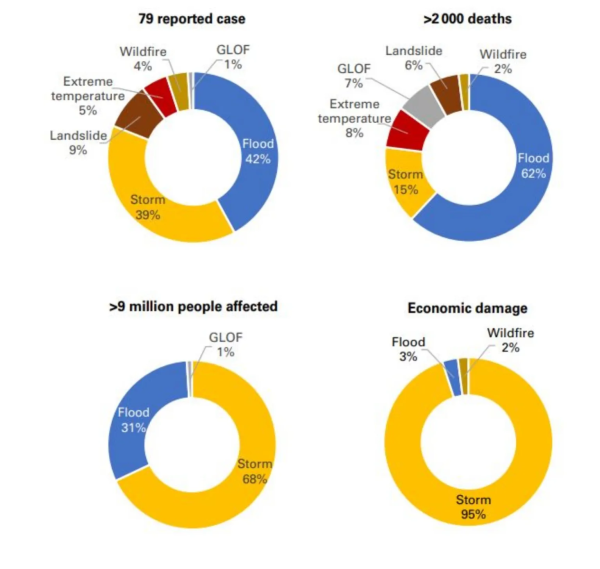 Overview of reported disasters in 2023 associated with hydrometeorological hazards in the Asia region. ESCAP and The International Disaster Database (EM-DAT).
Overview of reported disasters in 2023 associated with hydrometeorological hazards in the Asia region. ESCAP and The International Disaster Database (EM-DAT).
— Recently, the Supreme Court of India has ruled that people have a “right to be free from the adverse effects of climate change”, which should be recognised by Articles 14 and 21 of the Constitution.
— “The warming trend in Asia in 1991–2023 was almost double the warming trend during the 1961–1990 period, and much larger than the trends of the previous 30-year periods.”
— “In the glaciological year 2022-2023, 20 out of 22 observed glaciers in the High Mountain Asia (HMA) region — a high-elevation area centred on the Tibetan Plateau.”
— “In 2023, rainfall was below normal in large parts of countries like Turkmenistan, Pakistan, and Myanmar. In India, the summer monsoon season rainfall, averaged over India from June to September, was about 6% below the 1971–2000 average.”
Points to Ponder:
— Compare the impact of extreme weather events on Asia with Europe and America
— What is the impact of these disasters on developing nations?
— What needs to be done for disaster preparedness?
— Role of the international organizations to counter extreme weather events
Post Read Question:
Who released the report ‘State of the Climate in Asia 2023’?
(a) Asian Development Bank
(b) Intergovernmental Panel on Climate Change
(c) Climate and Health Council
(d) World Meteorological Organisation
Other Important Articles Covering the same topic:
Centre asks states to monitor, inspect organ transplants involving foreigners
Syllabus:
Preliminary Examination: Current events of national and international importance
Mains Examination: GS-II, Issues relating to development and management of Social Sector/Services relating to Health, Government policies and interventions for development in various sectors and issues arising out of their design and implementation
What’s the ongoing story- Pointing to reports of alleged commercial dealings in organ transplants involving foreign citizens, the Union Health ministry has directed state authorities to investigate such cases and take appropriate action for violations, if any.
Prerequisites:
— Who can donate their organs?
— What is the National Organ and Tissue Transplantation Organisation (NOTTO)?
Key takeaways:
— The Centre has directed the states to ensure that a NOTTO ID is generated for the donor and recipient for living-donor as well as deceased-donor transplants.
— Organs of the deceased donor are anonymously allocated to people waiting for a transplant, while an organ can be donated by a living person only if they (donor and recipient) are close relatives or share a close bond and want to donate altruistically.
— Commercial trading of organs is not allowed under Indian laws.
For Your Information:
— Allegations of “kidney scams” have surfaced at Delhi’s Apollo hospital.
— In India, the embassies need to provide a ‘Form 21’ certifying the relationship between the donor and recipient for organ transplantation.
— Form 21 is a key document considered by the Authorisation Committee, which approves the transplants, to show that the donor and recipients are indeed related and there is no commercial trading of organs.
— The form mentions basic details of the donor and recipient such as name, age, sex, name of father or husband, and address, along with a photograph. The certificate needs the embassy to mention the relationship between donor and recipient and state that the documents provided for identification are authentic.
Points to Ponder:
— Is there any age cap for receiving an organ from a dead donor in India?
— What is the National organ transplantation guidelines?
— Scenario of organ transplantation in India.
Post Read Question:
Highlight the policies and practices followed in India for organ transplantation. Do you think India has the potential to become a hub for medical tourism? Critically analyse.
(Thought process: Mention the Transplantation of Human Organs and Tissues (THOT ) Act enacted by the Indian government–point out any recent changes– compare with developed countries–why people from other countries prefer India?– where are the loopholes?–what needs to be done?)
Other Important Articles Covering the same topic:
Complete organ transplant process in 6-8 weeks, says Delhi HC. What was the case?
Economy Page
Govt plans to focus on 20 items as agri exports slips 9 per cent
Syllabus:
Preliminary Examination: Economy
Mains Examination: GS-III: Transport and marketing of agricultural produce and issues and related constraints.
What’s the ongoing story- As India’s agricultural exports slipped nearly 9 per cent between April to February in FY24 to $43.7 billion due to the Red Sea crisis, the Russia-Ukraine war, along with domestic restrictions, the government has begun formulating plans to boost exports of 20 items, including bananas, mangoes, potatoes, and baby corn, that have significant growth potential in the global export markets.
Prerequisites:
— What is Agricultural & Processed Food Products Export Development Authority (APEDA)?
— What are India’s top agriculture export and import products?
Key takeaways:
— At present, India’s share is low in global exports. According to the Additional Secretary in the Ministry of Commerce and Industry, Rajesh Agarwal, India’s share is about 2.5 per cent in global exports, and the aim is to increase it to about 4-5 per cent in the coming years.
— The items include fresh grapes, guava, pomegranate, watermelon, onion, green chili, capsicum, okra, garlic, groundnut, alcoholic beverages, cashew nut, buffalo meat, jaggery, and natural honey.
— While India’s exports of these commodities in 2022 were $9.03 billion, global imports were $405.24 billion, with the biggest buyers being the United States, Malaysia, Canada, Russia, Germany, France, Korea, China, Indonesia, Japan, Italy, Belgium, and the United Kingdom.
— The export ban and restrictions on commodities like rice, wheat, sugar, and onions have hit agri-exports by about $5-6 billion in the last fiscal year.
Points to Ponder:
— What is India’s Agricultural Export Policy?
— What are the challenges associated with agri-product exports in India?
— What are the initiatives taken by the government to promote the export of agricultural products?
Post Read Question:
Among the following, which one is the largest exporter of rice in the world in the last five years? (2019)
(a) China
(b) India
(c) Myanmar
(d) Vietnam
Other Important Articles Covering the same topic:
Importance of agri exports — and what Govt can do to boost India’s farm trade surplus
‘Extreme weather, geopolitical issues risk to near-term inflation’
Syllabus:
Preliminary Examination: Economic and Social Development
Mains Examination: GS-II, GS-III: Indian Economy and issues relating to planning, mobilization, of resources, growth, development and employment.
What’s the ongoing story- Adverse weather conditions and extended geopolitical conflicts that can result in volatility in crude oil prices may pose a threat to inflation in the near term, an article published in the Reserve Bank of India’s (RBI) monthly bulletin said. Consumer price index (CPI) inflation has gravitated to 4.9 per cent in March after averaging 5.1 per cent in the preceding two months following the recent peak at 5.7 per cent in December 2023.
Prerequisites:
— What is Inflation? What are the different types of inflation?
— What is the Consumer price index (CPI)? What is the difference between CPI and WPI?
— Read about the Asian Development Bank (ADB).
— Important terms to know: Southwest monsoon, La-Nina, El Nino, real gross domestic product (GDP).
Key takeaways:
— Food inflation, despite some signs of moderation, remains elevated and a potential source of risk to the disinflation trajectory, the ‘State of the Economy’ article published in the RBI’s March bulletin said.
— The article said that the World Meteorological Organization (WMO) sounded a red alert about global warming in its latest report “State of the Global Climate 2023”, stating that there is a high probability that 2024 will breach the threshold set in 2023 as the hottest year on record even as the world careens towards a freshwater shortage crisis.
— On the economy, the article said in India conditions are shaping up for an extension of the trend upshift that took the average real gross domestic product (GDP) growth above 8 per cent during 2021-24.
Points to Ponder:
— How extreme weather conditions and prolonged geopolitical tensions can affect the economic growth of the nation?
— What are the economic stakes of climate change?
Post Read Question:
Consider the following statements: (2020)
1. The weightage of food in Consumer Price Index (CPI) is higher than that in Wholesale Price Index (WPI).
2. The WPI does not capture changes in the prices of services, which CPI does.
3. The Reserve Bank of India has now adopted WPI as its key measure of inflation and to decide on changing the key policy rates.
Which of the statements given above is/are correct?
(a) 1 and 2 only
(b) 2 only
(c) 3 only
(d) 1, 2 and 3
Other Important Articles Covering the same topic:
El Nino: How the climate pattern may prolong food inflation
Explain Speaking: The economics of climate change in India
Front Page
Engineering in local language?
Syllabus:
Preliminary Examination: Current events of national and international importance.
Mains Examination: GS-II, Issues relating to development and management of Social Sector/Services relating to Health, Education, Human Resources.
What’s the ongoing story– R. Radhika writes- “three years ago, the Government launched engineering degree courses in regional languages as part of a new national plan to make technical education more inclusive and not allow lack of English to be a hurdle. Since then, 2,580 seats have been volunteered in local languages by 22 engineering colleges across the country — 18 private, the rest public.”
Prerequisites:
— What are regional languages?
— What is the New Education Policy (NEP), 2020?
— Constitutional provisions related to education
Key takeaways:
— “In line with the new NEP 2020, the AICTE approved 1,140 seats for BTech programmes in 11 regional languages — Hindi, Marathi, Tamil, Telugu, Kannada, Gujarati, Malayalam, Bengali, Assamese, Punjabi and Odia — across 18 engineering colleges for the academic year 2021-22.”
— “The move was part of the plan of including native languages as the medium of instruction in higher education to help increase access and promote the ‘strength, usage, and vibrancy of Indian languages”.
For Your Information:
— The new NEP pitches for a “5+3+3+4” design corresponding to the age groups 3-8 years (foundational stage), 8-11 (preparatory), 11-14 (middle), and 14-18 (secondary).
— This brings early childhood education (also known as pre-school education for children of ages 3 to 5) under the ambit of formal schooling.
Points to Ponder:
— What is the Kothari Commission?
— Initiatives taken by the government for inclusive education?
— Challenges in promoting regional language as a medium of education for higher education?
— When was ‘Education’ as a state subject transferred to the concurrent list?
(Thought Process: Bring out the historical background on reforms in education after independence-mention various commissions-highlight the features of the New Education Policy focussing on the promotion of inclusivity through multilingual approach-challenges in promoting regional language at higher education-lack of job and resources).
Post Read Question:
What are the key features of the New Education Policy, 2020? How does it promote a multilingual approach to education?
Other Important Articles Covering the same topic:
Explained: India’s National Education Policy, 2020
Ethics and Essay Snippet
From the World Page (AP),
“Vietnam paddy farmer uses different method of irrigation known as “alternate wetting and dying, or AWD”. This requires less water than traditional farming. Also, they produce less methane.
According to Food and Agriculture Organization Report, 2023, rice paddies contribute 8 per cent of all human-made methane in the atmosphere.”
(Thought process: This news can be utilized as an example or case study in GS and essay writing to discuss new techniques in irrigation methods especially in paddy farming. Additionally, it can be used to highlight the significance of alternate wetting and drying (AWD) in reducing methane emissions. This news can be used in essay and GS-new techniques in agriculture that can benefit farmers by reducing water requirements…Elaborate.)
‘Wordly Wise’ in The Editorial Page
“Age is an issue of mind over matter. If you don’t mind, it doesn’t matter.” – Mark Twain
(Thought process: Also refer to ‘Just A Number’ from today’s editorial. A study published in the journal Psychology and Aging titled ‘Postponing old age: Evidence for historical change toward a later perceived onset of old age’ has found that over time, the threshold for being considered “old” has moved forward. In addition, the older people get, the farther away they think old age is. Several research papers over the last decade have shown that young people are going through an extended adolescence. More gig work, increasingly expensive housing and less social security mean that the independence associated with being an adult is now coming much later. So, if people aren’t grown up till their middle age, why shouldn’t they be old later? A age number can’t dictate what you do and what you can’t do. Elaborate.)
Subscribe to our UPSC newsletter and stay updated with the news cues from the past week.
Buzzing Now
May 04: Latest News
- 01
- 02
- 03
- 04
- 05














